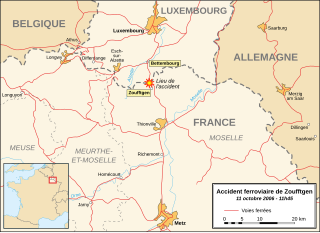
VR-Group Plc, commonly known as VR, is a government-owned railway company in Finland. VR's most important function is the operation of Finland's passenger rail services with 250 long-distance and 800 commuter rail services every day. With 7,500 employees and net sales of €1,251 million in 2017, VR is one of the most significant operators in the Finnish public transport market area.

The Selby rail crash was a railway accident that occurred on 28 February 2001 near Great Heck, Selby, North Yorkshire when a passenger train collided with a car which had crashed down a motorway embankment onto the railway line. The passenger train then collided with an oncoming freight train. Ten people died, including the drivers of the two trains, and 82 were injured. It remains the worst rail disaster of the 21st century in the United Kingdom.

The Southall rail crash occurred on 19 September 1997, on the Great Western Main Line at Southall, West London. An InterCity 125 high speed passenger train (HST) failed to slow down in response to warning signals and collided with a freight train crossing its path, causing seven deaths and 139 injuries.
The Charfield railway disaster was a fatal train crash which occurred on 13 October 1928 in the village of Charfield in the English county of Gloucestershire. The London, Midland and Scottish Railway (LMS) Leeds to Bristol night mail train failed to stop at the signals protecting the down refuge siding at Charfield railway station. The weather was misty, but there was not a sufficiently thick fog for the signalman at Charfield to employ fog signalmen. A freight train was in the process of being shunted from the down main line to the siding, and another train of empty goods wagons was passing through the station from the Bristol (up) direction.

The 2006 Zoufftgen train collision occurred around 11.45 am on 11 October 2006, near Zoufftgen, Moselle, France, some 20 metres from the border with Luxembourg, on the Metz–Luxembourg railway line. Two trains collided head-on while one track of a double track line was out of service for maintenance. Six people, including the drivers of both trains, were killed: two Luxembourgers and four French. Twenty more were injured in the collision, two seriously.
There have been a number of train accidents on the railway network of Victoria, Australia. Some of these are listed below.
The railways of New South Wales, Australia have had many incidents and accidents since their formation in 1831. There are close to 1000 names associated with rail-related deaths in NSW on the walls of the Australian Railway Monument in Werris Creek. Those killed were all employees of various NSW railways. The details below include deaths of employees and the general public.
The Wrawby Junction rail crash was a train crash which occurred on 9 December 1983, at Wrawby Junction, near Barnetby station, North Lincolnshire, England.
The Knowle and Dorridge rail crash was a fatal rail crash that occurred at Dorridge railway station in Warwickshire, England, on 15 August 1963. Three people died in the crash after a signalman's error routed a small freight train into the path of an express passenger train which slowed but could not stop before colliding with it.

The Hr1 class was the largest passenger express steam locomotive built in Finland. Twenty-two were built between the years 1937–1957. They were numbered 1000–1021.

VR Class Dr12 was a heavy diesel-electric locomotive of Valtionrautatiet. The first six locomotives were ordered in 1956. They entered service between 1959 and 1963. The locomotives were built by two manufacturers, Valmet and Lokomo, both based in Tampere. All Hr12 class locomotives with even numbers were produced by Valmet, while all odd numbers were produced by Lokomo. The locomotives were withdrawn in the early 1990s.






